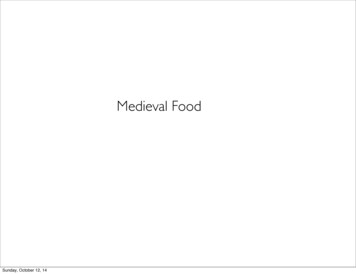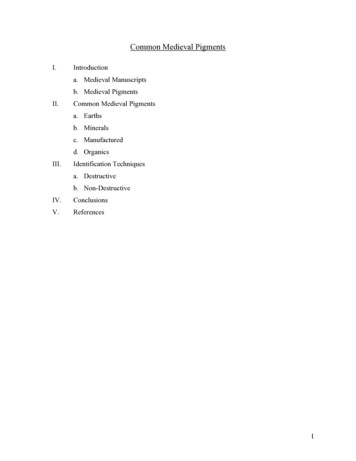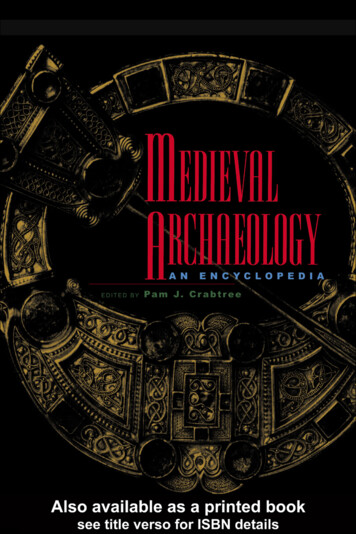
Transcription
Medieval FoodSunday, October 12, 14
AgricultureMore intense agricultureShift from animal products (meat and dairy)to various grains and vegetablesSunday, October 12, 14
Cereals were the stapleBarley, oat and rye for poorWheat for the governing classesSunday, October 12, 14
BreadFinely milled flour was expensive, whilethe bread of commoners was typicallybrown and coarseConsumption around 1 to 1.5 kilograms (2.2 to 3.3 lb) of bread per personper day.Among the first town guilds to be organized were the bakers', and laws andregulations were passed to keep bread prices stable.Nobility had their own baking staff, but there were public bakeries, normally owned by the local land lord,where the poorer people brought their bread to be baked communally, and later where they could buyready-baked bread.Sunday, October 12, 14
Bread and Food RegulationsFood regulations and the Assize of Bread and Ale.51 Hen. III, occurring about 1266–1267regulated the price, weight and quality of the bread and beer manufacturedlaid out harsh punishments for brewers and bakers who were caught cheating.Worshipful Company of BakersThe disreputable cook fromGeoffrey Chaucer's Canterbury Tales.Sunday, October 12, 14Bakers’ Guild had the very onerousresponsibility of enforcing the ‘BreadAssize’ within a radius of 2 milesfrom the City of London
Food (Bread) MachinesFor people in late medieval Europe, the mill, whether wind or water, was the best-known exampleof a machine that converted inanimate power to work.England had about ten thousand mills in 1300 andthat they ground 80 percent of the grain was millledin them“Four banal” (“common oven”) was a feudalinstitution in medieval FrancePersonal ovens were generally outlawed andcommoners were thus compelled to use theseigniorial oven to bake their bread.Sunday, October 12, 14
SugarThe spread of cultivation and manufacture of cane sugar to the medieval Islamic world togetherwith some upscaling of production methods.Crusaders brought sugar home with them toEurope after their campaigns in the Holy Land,where they encountered caravans carrying"sweet salt"Early in the 12th century, Venice acquired somevillages near Tyre and set up estates to produce sugarfor export to Europe,From its first appearance in Europe, wasviewed as much as a drug as a sweetener;original of candy as medicineSunday, October 12, 14
SpicesOver 288 spices in Medieval EuropeMost common were ginger, cinnamon,pepper, nutmeg, and saffronCommon myth about medieval food is that theheavy use of spices was a technique for disguisingthe taste of rotten meatCommon seasonings in the highly-spiced sweet-sour repertory typical of upper-classmedieval food included verjuice, wine and vinegar, together with sugar and spices.Common herbs such as sage, mustard, and parsley were grown and used in cooking allover Europe, as were caraway, mint, dill and fennel.Sunday, October 12, 14
SpicesSpices were, instead, as sign of luxury and affluence.Connection to trading routesAround 1,000 tons of pepper and 1,000 tons of the other common spices were imported intoWestern Europe each year during the late Middle Ages.Value of these goods was the equivalent of a yearly supply of grain for 1.5 million people.Sunday, October 12, 14
Sauces"Note that to every sauce and condiment salt isadded, and crumb of bread to thicken it." -The vast majority of medievalsauces are made with an acid e.g.vinegar, verjuice, or wine, as thebase and bread crumbs as thethickener.Almonds were very popular as a thickener in soups, stews, andsauces, particularly as almond milk.Sunday, October 12, 14
ByrdysA wide range of birds were eaten, including swans, peafowl, quail,partridge, storks, cranes, larks, linnets and other songbirdsMedieval pies (sometimes called "bake metis" in medievaldays) were often topped with either a pastry shell (oftencalled a "coffin") or "byrdys."Swans and storks apparently only eaten by the social elite, andmore for their appearances than for their meat.Sunday, October 12, 14
Food preservation1. drying,2. salting3. smokingspices, fruit, and fish4. pickling5. sweet Preserves6. fermentation7. ConfitsSunday, October 12, 14Connection of food preservation to trade,especially in fish and fruit (and spice)
Caloric Structure of DailyLifeDiets were very high-carbohydrate, with most of the budget spent on, and the majority ofcalories provided by, cereals and alcoholMeat contributed a negligible portion of calories to a typical harvest worker's diet; however, its shareincreased after the Black Death and, by the 15th century, it provided about 20% of the totalEven among the nobility of medieval England, grain provided 65-70% of calories in the early 14th centuryAdult peasant male ate 2,900 calories (12,000 kJ) per day, and an adult female needed 2,150 calories(9,000 kJ). Intakes of aristocrats may have reached 4,000 to 5,000 calories (17,000 to 21,000 kJ) perday.Monks consumed 6,000 calories (25,000 kJ) per day on "normal" days, and 4,500 calories (19,000 kJ)per day when fasting.Obesity was common among upper classes.Sunday, October 12, 14
CookbooksThe first cookbooks began to appear towards the end of the 13thcenturyLe Ménagier De ParisForme of CuryLe Viandier de TailleventLiber de CoquinaSunday, October 12, 14
CookbooksRecipes were pretty sparsei - Tartes de chare. Take Freyssche Porke, and hew it, and grynd it on a mortere; andtake it vppe in-to a fayre vesselle; and take the whyte an the3olkys of Eyroun, andstrayne into a Vesselle thorw a straynoure, and tempere thin Porke ther-with; than takePynez, Roysonys of Coraunce, and frye hem in freysshe grece, and caste ther-to pouderPepir, and Gyngere, Canelle, Sugre, Safroun, and Salt, and caste ther-to, and do it on acofynne, and plante thin cofynne a-boue with Pyne3, and kyt Datys, and gret Roysonys,and smal byrdys, or ellys hard 3olkys of Eyroun; and 3if thou take byrdys, frye hem on alytel grece or thow putte hem on thin cofynne, and endore with 3olkys of Eyroun, andSafroun, and lat bake til it be y-now, and serue forth.Smale Byrdys y-stwyde. Take smale byrdys, an pulle hem an drawe hem clene, anwashe hem fayre, an schoppe of the leggys, and frye hem in a panne of freysshegrece ry3t wyl; than ley hem on a fayre lynen clothe, an lette the grece renne owt;than take oynonys, an mynce hem smale, an frye hem on fayre freysshegrece, an castehem on an erthen potte; than take a gode porcyon of canel, an wyne, an draw thorwa straynoure, an caste in-to the potte with the oynonys; than caste the bryddys therto, an clowys, an maces, an a lytil quantyte of powder pepir ther-to, an lete hem boyleto-gederys y-now; than caste ther-to whyte sugre, an powder gyngere, salt, safron, anserue it forth.Sunday, October 12, 14
CookbooksGuillaume Tirel aka “Le Taillevent”One of the first truly "professional" masterchefs.Taillevent helped start the modern favoring of Burgundy andstrong (dry) red wine.Sunday, October 12, 14
CookbooksSunday, October 12, 14
MealsTwo meals / day. No breakfast: Moralists frowned on breaking the overnight fast tooearly, and members of the church and cultivated gentry avoided itFor practical reasons, breakfast was still eaten by working menStrong collectivist ethic of eating communally;many large households, courts and religiousorders forbade meals outside of the great hallat set times.The wife of the host often dined in private with her entourageor ate very little at such feasts. She could then join dinner onlyafter the potentially messy business of eating was done.Food was mostly served on plates or in stew pots, and dinerswould take their share from the dishesKnives were used at the table, but most people were expected to bring their own . importantguests got their own knives.Sunday, October 12, 14
Food and the churchFood practices at heart of christian tradition“The behavior that defined a Christian was food-relatedbehavior.”starvingmysticAsceticism in medievalthinkingBlessedLidwinaLenten food restrictions dominated the spring for MedievalChristiansFeast days and fast days and fish daysSunday, October 12, 14
Medieval Saints and Feast days as they would have been celebrated in the 14th Century. Dates were often given by the name of the event or feast dayof a saint.1 January - St Maelrhys, St Elvan & Mydwyn (2nd Century), Circumcision, The Solemnity of Mary2 January - St Basil the Great of Aix, France (329-379), St Gregory of Nazianzen (329-389)3 January - St Genevieve (Genovefe) of Paris (ca. 422-512)4 January - St Simeon the Stylite (390-459)5 January - St Julien, St Edward the Confessor, Twelfth Night, Vigil of Epiphany6 January - St Peter of Canterbury (d. 607), St Hywyn (Ewwn, Owen) of Aberdaron, Gwynedd, Wales (d. 516), Epiphany7 January - St Raymond of Pennafort (1175-1275), St Brannock of Braunton, England8 January - St Wulsin of Westminster (d. 1002)9 January - St Adrian of Canterbury (d. ca. 709), St Brihtwald (Berhtwald, Beorhtweald, Brihtwald) of Canterbury (d. 731)10 January - St Paul (d. 342), Geraint of Wales (9th Century)11 January - St Egwin of Worcester, St Brandan Of Ireland (5th Century)12 January - St Benedict Biscop of Wearmouth (d. 690), St Distaff's Day13 January - St Hilary (Hilarii) of Poitiers (d. 368), St Erbin (Ervan, Ernie, Erbyn, Hermes) of Cornwall and Devon (5th Century), St Kentigern Mungoof Scotland (d. 603), St Elian of Cornwall, England (6th Century)14 January - St Felix of Nola (d. 260), St Kentigern (ca. 516-601), St Deusdedit of Canterbury (d. 664)15 January - St Ita (Deirdre and Mida) (d. ca. 570), St Blaithmaic of Ireland (d. 823), St Ceowulf of Nortumbria, England (d. 764)16 January - St Honoratus of Aries, France (350-429), St Henry of Cocket Northumbria, England (d. 1127)17 January - St Antony of Egypt (251-356), St Milburga of Wenlock (d. 715)18 January - St Volusian of Tours (d. 496), St Ulfrid of England (d. 1028), St Day of Cornwall, England19 January - St Canutus of Denmark (Canute IV, Knud) (d. 1086), St Wulstan (Wulfstan) of Worcester (1008-1095), St Branwallader of Jersey (6thCentury)20 January - St Fabian (d. 250)21 January - St Agnes of Rome (d. ca. 305)22 January - St Paschasius of Vienne, France (d. 312), St Brithwald of Ramsbury (d. 1045)23 January - St Paul's Day, St Ormond of St Maire (6th Century)24 January - St Bertrand of Saint-Quentin (7th Century), St Cadoc (Docus, Cathmael, Cadvael, Cadfael) (d. 580)25 January - St Amarinus of Clermont, France (d. 676), St Dwynwen of Brecknock, St Eochod (d. 697), St Dwynwen of Wales26 January - St Eystein (d. 1168), St Margaret (1243-1271), St Alberic (d. 1109), St Paula (d. 404), St Robert of Newmister (1100-1159), St Conan (d.648), St Thordgith (Theoregitha) of Barking, England (d. 960)27 January - St Emerius (8th Century), St Gamo of Bretigny, France (8th Century), St Gilduin of Dol (d. 1077), St Julian of Le Mans (3rd Century)28 January - St Cannera of Bantry, Ireland (d. 530), St Antilnus of Brantome, France (8th Century), St Thomas Aquinas (1226-1274)29 January - St Gildas the Wise (d. ca. 576), St Blath (d. 523), St. Voloc (d.724)30 January - St Aidan of Connaught (Edan, Modoc, Maedoc) (d. 626), St Adamnan of Coldingham (d. 680), St Madoes31 January - St Aedh (Aiden) of FernsSunday, October 12, 14
Food and the church: gluttonyPope Gregory I description of gluttony:1. Eating before the time of meals in order to satisfy thepalate.2. Seeking delicacies and better quality of food to gratifythe “vile sense of taste.”3. Seeking to stimulate the palate with sauces andseasonings.4. Exceeding the necessary quantity of food.Sunday, October 12, 14
Food and the ChurchWednesdays and Fridays (Saturdays sometimes too) were fastand then later Fish days.The approved foods for consumption included fish and all otherwater creatures as well as fruits, vegetables and breads.“As fish was a relatively pliable meat, it was oftensculpted to reflect things that could not be eaten, forexample, salmon was sculpted into pork sculpturesand white fish was stuffed into cleaned egg shells sothat it appeared to be a boiled egg.”Sunday, October 12, 14
Food and The ChurchMonasteries as productioncentersSunday, October 12, 14
Food and ClassCuisine of nobility took on foreign influence via trade.Innovations from international trade and foreign wars from the 12th century were also taken upby upper middle class in medieval cities.With the rise of the middle class, the nobles felt there needed to be control on the personalspending of these nouveau riche. They enacted Sumptuary Laws to regulate and reinforce socialhierarchies and morals through restrictions on e.g. food.Phillipe Le Bel in 1294 forbade every subject to have served as an ordinary mealmore than one dish and one side dish, and for larger meals, more than twodishes with a potage au lard.In England in 1363, servants of gentlemen, merchants, and artificers, should onlyhave one meal of meat or fish in a the day and that their other food shouldconsist of mild, butter, and cheese.Sunday, October 12, 14
Common seasonings in the highly-spiced sweet-sour repertory typical of upper-class medieval food included verjuice, wine and vinegar, together with sugar and spices. Common herbs such as sage, mustard, and parsley were grown and used in cooking all over Europe, as were caraway, mint, dill and fennel. Sunday, October 12, 14File Size: 1MB










